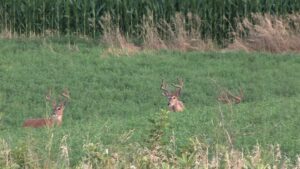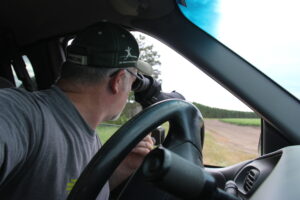The first two weeks of August are the first—and possibly the best—time to get a look at the deer in your area. This is when the hunting actually starts.
By Bernie Barringer
Late summer is an easy time for whitetail bucks. Food is everywhere, the hunting pressure is off, and the stress of growing antlers is winding down. Other than a few bugs and finding water every day, there’s not much for a buck to do.
Green crops, such as soybeans, clover and alfalfa are the preferred foods at this time, although deer will nibble on corn if it’s in the milk stage. Bucks that would never be caught in the daylight during the hunting season will be leisurely browsing in the fields an hour before dark. There a many things a hunter can learn from watching the deer this time of the year.
You can see some activity with binoculars, but to really get a good look at the deer and their surroundings, it’s a good idea to invest in a quality spotting scope with a window mount and a tripod. You can spend thousands on a spotting scope if you want, but a mid-priced scope such as the Nikon Prostaff series 20-60×80 will run $500-$600 and bring the deer up close for you. You will need to mount the scope solid, thus the need for the window mount when glassing a field from a high point on a road, or the tripod, when you have to walk to a vantage point and observe from a place you can conceal yourself.
Let’s take a look at some important things you can learn from watching these late summer deer in the fields.
Inventory
The first advantage you have is the ability to inventory the bucks. All bucks will not be visible every evening, but if you watch their preferred feeding area for a few days, you are most likely to get a look at the majority of the bucks in the area. This helps you understand the potential for the upcoming season. Keep in mind that bucks will move quite a bit during September, and some of your bucks will leave while others may come in, but knowing some generalities of the deer available to you will help you choose what caliber of buck you will want to hold out for come early hunting season.
Habits and entry points
It’s surprising how much knowledge about deer behavior can be had just by observing where and when the bucks enter the fields. One year I watched as a mature buck entered the alfalfa through a ditch that bisected the field. He would just appear at the point of the ditch and move cautiously out into the field whenever the wind direction allowed him to feel safe.
The following year, that buck was nowhere to be found, but a different mature buck was entering the field in exactly the same way. This pattern has been repeated through the years. Bucks have tendencies and comfort levels; they use the terrain in certain ways. Once you learn these tendencies and the points they prefer to enter the fields. You have a potential hunting spot for the opening days of the season.
Staging areas
Bigger bucks often enter the fields last. They will sometimes hang back where they can observe the deer already in the field, usually does and young bucks, through sight and smell. They will watch the body language of the deer in the open to determine the safety level of the field. The areas they hang out in I call Staging Areas. These are perfect places to hang a scouting camera. They are also excellent treestand locations for early season bowhunting.
Wind directions and Stand set-ups
Once you observe the deer for several evenings, you will notice that the bucks tend to enter the field in different places depending on wind direction and sky conditions. I have noticed that deer tend to avoid walking up a hill with the sun directly in their eyes. They will enter a field in a different location based on whether it’s overcast or sunny.
Wind direction is a key to where the deer enter the field. This is not to say that they will only move into the wind, but they will take advantage of the wind on the side of their face when they can. Evening thermals carry scent downhill, and the bucks will take advantage of that.
Having the knowledge of where the bucks tend to enter the field based on wind direction will be a huge advantage in choosing where to set your stands and which ones to hunt based on the prevailing wind directions of the day.
Behavior and Interactions
While most of the topics I have discussed to this point have the end goal of helping you shoot a buck you have spotted during August, there are advantages to glassing deer that just help us better understand the species. Watching deer and observing how they act, react and interact can be very educational.
The ways in which does interact can be very interesting. Over time, you can figure out which does are the dominant ones. One matriarchal doe is usually a leader, and often looks around more than the others; a sentry so to speak. The other does look to her for guidance.
Bucks will exhibit dominance tendencies as well. Often, when a mature buck enters the field, the other bucks will stare at him for a while. If he moves close to one of them, the subordinate buck will move off. Rarely do you see confrontations during this time, but the pecking order becomes clear if you are observant.
You can learn a lot from watching deer; the information you gather can help you understand the deer in your area much better, and it can also lead to a greater chance of shooting a nice buck in the early days of the archery season.
